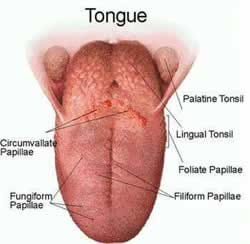Thrush(candida albicans) infection can affect a mothers' breast while she is breastfeeding. It often occurs after either mother or baby takes antibiotics or after damage to the nipple. [b]Signs of thrush in the mother[/b] [li]sudden start of breast and /or nipple pain after some days or weeks of pain-free breastfeeding - the nipple may also be itchy or be super-sensitive to any touch- even loose clothes[/li] [li]shooting pains in the breast(may be deep in the breast) after feeding - pain[/li] [li]cracked nipples which don't heal[/li] [li]loss of colour in the nipple or areola[/li] [li]pain occurs in both breasts(except in the early stages) because the baby transfers the infection during feeding[/li] [b]Signs of thrush in the baby[/b] [li]creamy white patches in baby's mouth or on tongue[/li] [li]white sheen on baby's tongue which does not rub off[/li] [li]baby keeps pulling off or away from the breast while feeding, seems unhappy or uncomfortable - this is probably because the baby's mouth is sore[/li] [li]the baby may be windy, fretful and find it hard to settle down[/li] [li]nappy rash(usually red spots or soreness which is difficult to heal)[/li] [b]Note: Baby may show no signs of infection[/b] [b]If you think you have thrush[/b] It can be difficult to be sure that the problems you are having are due to thrush. It is possible to confuse some of the symptoms of thrush with the difficulties resulting from poor attachment(fixing) of the baby tothe breast. Before deciding that thrush is the cause of your painful breastfeeding, you should ask your midwife, health visitor or observe a full breastfeed.
[b]BREASTFEEDING SHOULD BE PAIN-FREE[/b].
(Pain from thrush begins after a feed). If the slightest doubt exists, seek someone experienced to help you with attachment and positioning [b]Other causes of nipple pain[/b] [li] attachment of the baby to the breast: may need fine-tuning [/li] [li]eczema, including reactions to breast pads or creams[/li] [li]tongue-tie in the baby[/li] [li]Raynaud's syndrome(poor circulation)[/li] [li]white spot or bleb[/li] [li]bacterial infection(may be present at the same time as thrush)[/li] [b]Self-help measures[/b] thrush can be passed between you and your baby - and also your partner and other children it is necessary to be very careful with hygiene in order to get ride of thrush completely - be sure to wash your hands well after each nappy change use a separate towel for each person in the family if your baby is also sucking on a dummy, bottle teat, nipple shield or plastic toys, make sure these are carefully washed and sterilised(boiling for 20 minutes while the infection lasts may be best) if you have expressed your milk and saved it in the freezer during the time you or your baby had thrush, it is better not to use it as it could cause another bout of thrush acidophilus capsules can help to restore bacteria which can keep thrush under control ( available from health food stores or chemists) you may find you need painkillers to help you cope with the pain of thrush carry on breastfeeding Note: - To make sure that you get rid of thrush infection, both you and your baby need treatment. Usuallyy once treatment begins the pain and other symptoms will begin to improve within 2 or 3 days. It may take longer for full recrovery and treamtnt should not stop before 10-14 days to be continued ....
Source:




 Excellent
Excellent








